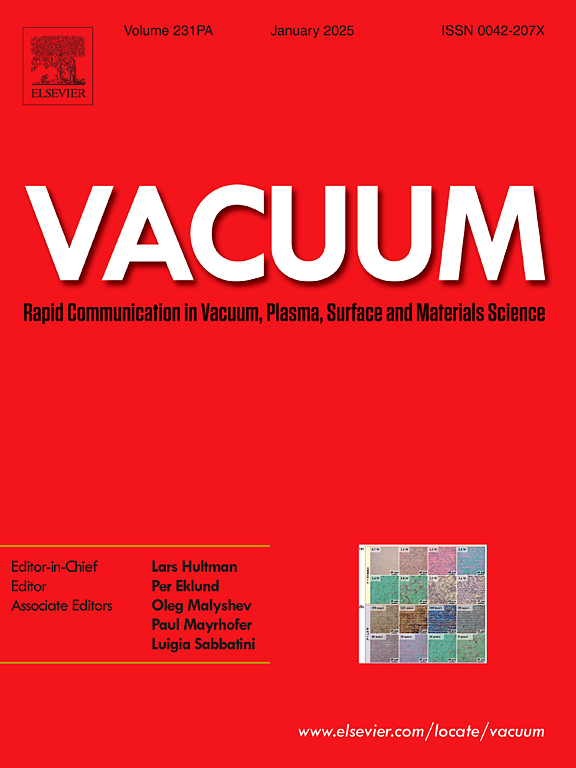用DFT分析Ru(0001)、Ru(10-10)和阶梯Ru(10-11)表面上碳的原子尺度行为:对EUV多层反射镜性能的影响
IF 3.8
2区 材料科学
Q2 MATERIALS SCIENCE, MULTIDISCIPLINARY
引用次数: 0
摘要
本研究采用密度泛函理论(DFT)研究阐明了三种具有代表性的钌(Ru)表面:Ru(0001)、Ru(10-10)和阶梯Ru(10-11)表面上碳相互作用动力学的晶体学工程原理。普遍观察到的空位点吸附偏好表现出由局部配位几何决定的位点特异性层次变化,共价键-金属键杂交驱动大量的界面电荷重新分配。这些电子结构的变化引起了吸附能量学中的晶体各向异性,这从根本上控制了碳通过表面依赖的动力学机制的运输机制。使用爬升图像轻推弹性带(CI-NEB)方法分析Ru表面晶体学可以深入了解碳动力学:阶梯形Ru(10-11)表面可以实现无障碍碳渗透,但以结构脆弱性为代价;Ru(10-10)表面通过选择性动力学瓶颈在可清洁性和稳定性之间取得平衡;Ru(0001)表面延迟了碳通过级联屏障的渗透。本研究从原子尺度的角度研究了从表面去除杂质碳原子相关的挑战,为优化极紫外(EUV)应用中钌基多层反射镜(mlm)的设计提供了理论见解。本文章由计算机程序翻译,如有差异,请以英文原文为准。
Atomic-scale analysis of carbon behavior on Ru(0001), Ru(10–10), and stepped Ru(10–11) surfaces using DFT: Implications for EUV multilayer mirror performance
This study employs density functional theory (DFT) to investigation elucidates crystallographic engineering principles governing carbon interaction dynamics across three representative ruthenium (Ru) surfaces: Ru(0001), Ru(10–10), and the stepped Ru(10–11) surfaces. Universally observed hollow-site adsorption preferences manifest site-specific hierarchy variations dictated by local coordination geometries, with covalent-metallic bonding hybridization driving substantial interfacial charge redistribution. These electronic structure variations induce crystallographic anisotropy in adsorption energetics, which fundamentally controls carbon transport mechanisms through surface-dependent kinetic regimes. Using the climbing image nudged elastic band (CI-NEB) method to analyze Ru surface crystallography provides insights into carbon dynamics: The stepped Ru(10–11) surface enables barrierless carbon penetration, but at the cost of structural vulnerability; the Ru(10–10) surface strikes a balance between cleanability and stability through selective kinetic bottlenecks; the Ru(0001) surface delays carbon penetration through cascaded barriers. This research provides an atomic-scale perspective on the challenges associated with removal of impurity carbon atoms from surfaces, offering theoretical insights for optimizing the design of ruthenium-based multilayer mirrors (MLMs) in extreme ultraviolet (EUV) applications.
求助全文
通过发布文献求助,成功后即可免费获取论文全文。
去求助
来源期刊

Vacuum
工程技术-材料科学:综合
CiteScore
6.80
自引率
17.50%
发文量
0
审稿时长
34 days
期刊介绍:
Vacuum is an international rapid publications journal with a focus on short communication. All papers are peer-reviewed, with the review process for short communication geared towards very fast turnaround times. The journal also published full research papers, thematic issues and selected papers from leading conferences.
A report in Vacuum should represent a major advance in an area that involves a controlled environment at pressures of one atmosphere or below.
The scope of the journal includes:
1. Vacuum; original developments in vacuum pumping and instrumentation, vacuum measurement, vacuum gas dynamics, gas-surface interactions, surface treatment for UHV applications and low outgassing, vacuum melting, sintering, and vacuum metrology. Technology and solutions for large-scale facilities (e.g., particle accelerators and fusion devices). New instrumentation ( e.g., detectors and electron microscopes).
2. Plasma science; advances in PVD, CVD, plasma-assisted CVD, ion sources, deposition processes and analysis.
3. Surface science; surface engineering, surface chemistry, surface analysis, crystal growth, ion-surface interactions and etching, nanometer-scale processing, surface modification.
4. Materials science; novel functional or structural materials. Metals, ceramics, and polymers. Experiments, simulations, and modelling for understanding structure-property relationships. Thin films and coatings. Nanostructures and ion implantation.
 求助内容:
求助内容: 应助结果提醒方式:
应助结果提醒方式:


